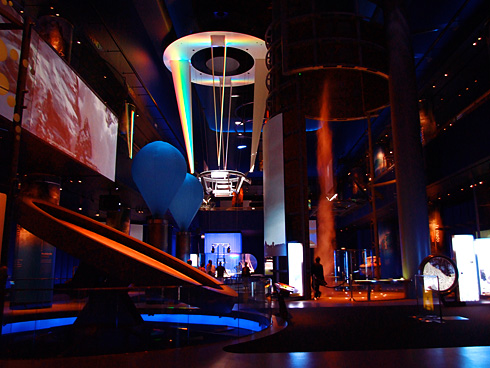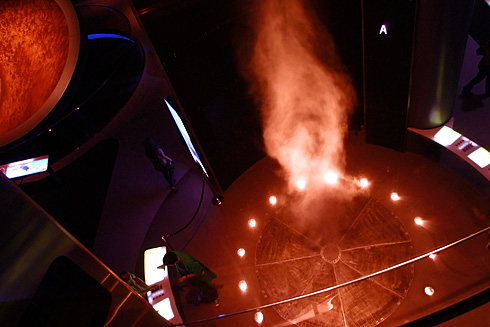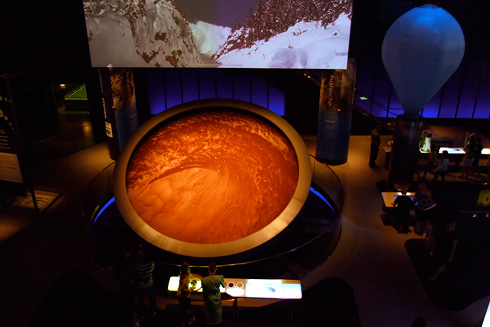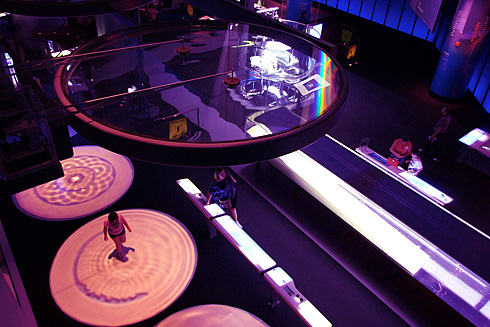The following article was written by Marco the Spacefarer, a small spaceman who sometimes follows me on my adventures. I hope you enjoy his… unique perspective.
As I looked over the photos of the Science Storms exhibit, I was reminded at how much I enjoyed my time there, and not just because I savor the act of stalking Andrew on his little adventures, either. Even though your human technology is almost entirely pathetic, it is nonetheless amusing to watch you play with it, especially when you get shocked, and at least one of the exhibits offered this attractive possibility…
I’d also forgotten just how much crap they’d managed to shove into that space. And today, I’m excited to have the honor of pointing out the flaws and sheer atavism in six attractions within the Science Storms exhibit, complete with snarky remarks beneath each photo.
I mean, seriously. Look at how much they managed to cram in:
Yet somehow that room felt spacious. Primitive, yet spacious, so let’s begin. We’re going to have some fun together.
1. The Tornado Vortex Machine
A sign beside this amusing machine explained that a tornado is a massive air vortex. Oh, really? Because I thought it was made up of wind faeries and strawberry daiquiris. Please. The sheer level of ignorance that precludes such a sign boggles my mind. I knew earthlings were ignorant, but this is child’s play, my friends.
Anyway, I have to admit that it was fun to watch, even if the vortex fan controls had the response time of a Rube Goldberg machine.
2. The Avalanche Simulator Disk
Now this one, while simplistic on the surface, actually had a fair bit going on underneath. Literally. As any spacefarer knows, three forces are at work during an avalanche: friction, gravity, and particle collisions. And a nearby sign even explained these forces, including the additional centripetal force of the spinning disc, as well. There was even a camera controlled by a touchscreen beside the sign.
Even after Andrew had left, I stood there for some time, admiring the rusty grains creating ever-changing patterns on the disc below. It reminded me of my own world.
3. The Wave Difference Pattern Generator
Speaking of patterns, here’s a device that would have truly been an embarrassment were it not for one simple fact: the watery patterns projected onto the floor below were quite beautiful. In the photo above, you can even see a girl playing in the center of one.
If you’re not familiar with these (and being an Earthling, I wouldn’t be surprised), these patterns are produced by two or more waves colliding, creating a difference pattern. In this case, the effect is produced by projecting light through a shallow pool of water.
4. The Tesla Coil
A-ha! At last something moderately dangerous to look at! Even though it was woefully underpowered to be truly useful, it was amusing to see it form bright, purple bolts every few minutes. Although it was underpowered, it was still pushing more volts than the average human ever sees. (Reminder: get one of these for the ship, only bigger.)
5. Interactive Chemistry Reaction Lab Computer
Out of everything I saw in the exhibit that day, this was the only point of interest that really entertained me for a considerable period of time. After Andrew played with it for a good 20 minutes, I walked up, still carefully camouflaged, and tried to deduce the workings of this primitive physical computer.
What I found was surprisingly enjoyable. On the surface of a long table were small black discs. When placed over a projected image of the periodic table of elements, the disc would “become” any atom that you placed it over. And when you combined different discs, different molecules would result, often prompting the machine to show a short video of that element in action. After a short time, I had produced Potassium Carbonate, but was sadly unable to extract the material from the machine. Clearly, it was in some state of disrepair.
6. The Delightfully Dangerous Ferromagnetic Fluid
Lastly, I stumbled across a truly intriguing material: ferromagnetic fluid. If you’re not already familiar, this is a fluid that responds to magnetic fields, which causes the unique shape you see above. Those pointy ends are actually where the magnetic field waves are the strongest, and I had endless fun adjusting the strength of the magnet and modulating the porcupine-like shape (if endless fun is roughly two minutes, that is).
Anyway, that concludes this brief tour of the Science Storms exhibit. If you are coming to this museum, you would indeed have a solid argument for punching yourself in the face if you missed this exhibit.
An Open Letter to the Museum of “Science” & Industry:
Man up and buy/rent/steal a bigger Tesla Coil, put it in a room, and create lightning that actually scares people. You humans are too unaware of your own mortality, not to mention the beauty of an electric storm. Experiencing both up close would help you cultivate a healthy respect for the true power of electrons and do you all a world of good.
Also, record it and share the videos. That is all.
(More photos await you in: The Science Storms photo gallery.)







